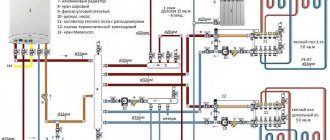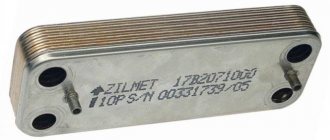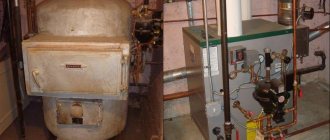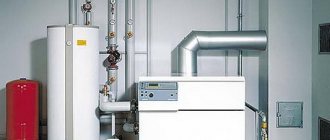At different times, the issue of heating remains relevant for people. Perhaps one of the most popular heat sources are gas boilers - devices for generating thermal energy in premises for various purposes. First, you need to understand the principle of operation and structure of gas boilers of different types: wall-mounted, floor-mounted, double-circuit.
Gas boilers are used for two purposes:
- Heating (of premises, objects for various purposes);
- Heating water (for taking a bath, washing dishes, etc.).
According to the operating principle and depending on the purpose, gas boilers are divided into:
- Single-circuit;
- Dual-circuit.
Basic design of a wall-mounted gas boiler
The external structure of such a gas boiler includes:
A housing that protects the boiler itself from fire and from outside interference for its high-quality operation
Control panel for entering certain commands that regulate the heating temperature, respectively, and the water heating temperature. By design, the control panel can consist of either any rotary knobs or touch buttons- A display that clearly displays the temperature that we set using the control panel, what stage the heating is currently at, possible errors and failures in the system, with which you can determine exactly what problems have arisen with the boiler
- A pressure gauge (mechanical or electronic), with which we can see the pressure of liquids in the heating system.
It is worth noting that modern boilers operate only in closed systems with a water pressure in this system of 1 to 2 atm.
The internal structure of a gas boiler includes:
- Primary heat exchanger
- Gas-burner
- Pump
- Gas fittings
- Secondary heat exchanger
- Three-way valve
- Turbine (smoke exhauster)
Let's consider the operating principle of a gas boiler , examining in detail each element of the internal structure:
Frost protection
The most important mode is frost protection. The mode is active when the boiler is switched off or winter mode is switched off. Why is it needed:
- the burner continues to work;
- the boiler was in working order;
- works when the heating is turned off.
Not every boiler has a protection mode. When the boiler turns on when water is supplied, the outlet water temperature is checked. Each boiler has a separate threshold, most have 5 degrees. If the temperature is 5 degrees, the boiler brings it to 15, then turns off.
Primary heat exchanger
gas boiler heat exchanger
It is a determining element in the operation of the boiler; it serves to transfer heat from the fire to the heating fluid further into the heating system. The design of the heat exchanger is usually the same for all types of gas boilers from manufacturers. Externally, it is a copper pipe with heating fluid flowing inside it. Such heat exchangers are called “copper”. Since the heat exchanger is located above the burner flame, the heat from the fire heats the copper pipe, which transfers the heat to the heating fluid. It is noteworthy that copper was chosen as a metal that successfully copes with the task of retaining heat and, if necessary, losing it quite quickly, because has a high heat transfer coefficient. Also, copper does not rust quickly, due to which its service life is quite long. In addition to the copper pipe, the heat exchanger is equipped with special plates that help smoothly distribute all the heat from the fire, thereby promoting uniform heating of the heat exchanger.
What’s better: setting up the boiler yourself or calling a specialist?
Setting up a boiler is a difficult task, but quite feasible. In this matter, you need to understand and take into account many factors, the main one of which is safety. It is important to understand that this equipment runs on gas. When working with it, special care and caution will be required.
When you just need to configure the programmer, choosing the desired mode is not difficult. And if there is a need to get into the boiler structure and disassemble it, it is better to use the services of a specialist.
Gas-burner
gas boiler burner
The principle of the burner design of a wall-mounted gas boiler is similar to the burner of a gas stove, with the only difference being the dimensions and appearance. As in a gas stove, the greater the boiler power, the larger the burner. It is noteworthy that the dimensions of the burner directly coincide with the dimensions of the heat exchanger, which allows the boiler to be ergonomic. This type of burner is called “injection”. Its operating principle is that gas and primary air are supplied to the burner. Inside it, mixing and formation of a gas-air mixture occurs. Next, the prepared mixture exits through the holes in the burner, mixes with secondary air and enters the combustion chamber, ignited using the electric ignition available in each boiler. The combustion chamber, as a rule, is closed with special covers and protected from heat leakage and overheating of the housing by asbestos plates. When gas burns, fire and smoke are generated.
Heat exchanger and burner of a gas boiler
Selecting the wiring type
Gas heating allows any type of wiring. They choose a scheme based on the area of the house, number of storeys, convenience and possibilities, including financial ones.
The wiring, along with the area, determines the power of the boiler and the need for one or another electrical equipment.
Wiring type
There are 3 options: single-pipe, double-pipe and beam.
- The single-pipe scheme is the simplest. One pipe is sequentially supplied to each radiator along its “path” and returns to the boiler. Here the coolant heats up and the cycle repeats. Suitable for small buildings and technical structures.
- Two-pipe - one pipe goes from battery to battery and carries hot water. The second pipe removes the cooled coolant from the radiators in the opposite direction. This scheme ensures more uniform heating of the entire circuit and can serve a larger area. The use of taps makes adjustments easier. The system is used for heating residential buildings and cottages.
- Radial - here the heated coolant first enters the collector, and from here hot water is supplied to each radiator through an individual pipe. This scheme allows not only to uniformly heat a very large area, but also to heat individual rooms in a random order, heating them to different temperatures. Installation is very expensive, as it requires laying a large number of pipes and very precise settings.
A one- and two-pipe system can be natural, a radial system can only be forced.
Water circulation
In simple systems, it is possible to ensure that water flows by gravity from one battery to another. In this case, the pipes are laid at a certain angle, and an expansion tank is placed at the top point of the system. The latter compensates for the difference in pressure. The scheme requires precise calculations. Not suitable for “warm floors”.
Forced – the movement of the coolant is provided by an electric pump. This is more expensive, but it solves all the problems with a large number of pipes and a complex pipeline configuration.
Vertical and horizontal
This type of wiring is related to the location of the supply pipes.
Horizontal – supply and discharge pipes are located horizontally. In one-story buildings, this option is used, since it is very simple and allows you to do without a pump.
Vertical - heating radiators are divided into some kind of sections, for example, along one wall. A vertical pipe is connected to the section and hot water is supplied through it. It is also discharged through a vertical drain. This scheme is carried out in multi-apartment and multi-storey buildings.
Vertical wiring can only be forced. Here you definitely need a circulation pump to pump water.
Pump
Pump in a gas boiler
Serves to impart movement to the coolant. This device causes heating fluid to circulate from the heated primary heat exchanger to the radiators, heat them and move back to heat them. The pump usually has several speeds and is adjusted by a service engineer based on the size of your heating system.
Too high a pump speed can create additional noise and reduce the efficiency of the boiler. And too small will lead to uneven heating of the radiators. Therefore, for proper setup, it is very important to contact qualified service engineers.
Beretta CIAO 24 CSI
The Beretta brand is the property of one of the leaders in the European heating industry - the Italian company Riello, which is approaching its 100th anniversary.
Beretta boilers are manufactured using modern technologies and fully comply with European requirements for safety, economy and efficiency. The CIAO 24 CSI model is manufactured in accordance with the most advanced technical developments and is capable of meeting the needs of a modern residential building.
The units are manufactured in a wall-mounted design, have a compact and visually attractive body, which allows them to be installed directly in the kitchen and without having to allocate a separate room for the boiler room.
NOTE! The successful combination of price and quality of the Beretta CIAO 24 CSI model is highly appreciated by specialists and users, which confirms the steady demand and relevance.
Secondary heat exchanger
Responsible for heating water for household needs. Considering the design of a gas boiler, it is worth noting that this element is made of food-grade stainless steel plates. On one side, heated heating fluid moves through the heat exchanger, and on the other, cold water. When the heating fluid meets, it transfers its heat to cold water through a thin layer of metal. In this way, the water is heated and then flows into consumers’ taps. In this case, the heating fluid loses its temperature, entering the primary heat exchanger for subsequent heating. Such a heat exchanger has from 8 to 30 alternating layers and allows you to heat a fairly large amount of water.
Design of a double-circuit gas boiler
There is a slight difference in the device itself. In double-circuit gas boilers there is not one, but two heat exchangers - primary and secondary:
- The primary heat exchanger performs the same role as the heat exchanger of wall-mounted and floor-standing boilers - it serves to heat the room and is represented by a copper or steel tube. True, the latter is less profitable to use due to the fact that it is prone to corrosion. Copper has no such drawback.
- A secondary heat exchanger is precisely needed to heat water for household needs. It can be made of steel. It is affected by a temperature slightly lower than the temperature that reaches the primary heat exchanger. The point is in the mechanism of operation of the secondary heat exchanger itself. Two liquids move through the heat exchanger: one is the boiler coolant, the other is the very water that the owner plans to use for washing, for example. When these two liquids meet, the coolant shares heat with service water through a thin layer of metal, and then again enters the primary heat exchanger (restore the previous temperature). While the household water, having heated up, reaches the taps of sinks and bathtubs. This is how it heats up. The secondary heat exchanger most often has quite a few alternating layers, which helps to warm up an impressive amount of water well.
Since double-circuit gas boilers have such a difference in design compared to single-circuit ones, their operating principle is somewhat different.
On the left is a three-way valve made of brass. On the right with a blue head there is a gas valve. The secondary heat exchanger shines at the back.
Automation systems
Modern gas boilers are equipped with two types of automation:
Working
Controls the operation of the boiler (controls power or switches it on/off) in order to maintain the temperature of the coolant or air in the room at a user-specified level (depending on where the temperature sensor is installed).
The most “advanced” is weather-dependent automation, which takes into account the outside temperature and therefore adjusts the boiler operating mode in a more timely manner.
At the same time, the system controller constantly “learns”, remembering how the temperature in the room changes at certain boiler heating outputs and outside temperatures.
Do you know what a heating distribution comb is and what it is used for? Read more about this in the article.
You will find recommendations for making a burner for a biofireplace with your own hands in this material.
Security automation
Consists of an electromagnetic valve at the gas inlet to the burner and sensors connected to it:
- traction;
- coolant overheating;
- flame on the burner.
If the boiler has an igniter, then a thermocouple is also connected to the valve, which blocks it when the igniter goes out.
Other sensors block the gas supply in case of emergency situations - deterioration of draft, overheating of the coolant or extinguishment of the flame on the main burner.
Chimney design
The chimney structure of a gas boiler is extremely important for the operation of the boiler, since it is thanks to it that combustion products are removed from the apparatus. True, it is a tube, and there are no special devices in it. However, they come in different types:
- Metal. They are sandwich panels made of lines of different diameters, made of stainless steel. The voids between them are usually filled with a basalt thermal insulation layer. They are highly reliable. They are multi-layered and have high heat-insulating properties. But they are assembled from a large number of parts, which is not entirely convenient.
- Ceramic. Simpler, but no less durable models. They even resist the effects of chemical substances. They are ceramic pipes wrapped in mineral wool. However, they require additional installation of condenser collectors.
- Coaxial chimney. Easy to use and looks great. Does not require installation of any additional devices. Condensation does not accumulate, which is also its advantage. And it is something like a pipe-within-a-pipe design. Can be used for closed type boilers (those that take air from the street. Open systems take air from the house). That is, air enters the boiler through the outer pipe, and exits through the inner pipe, being exhausted.
Coaxial chimney
Previously, a brick chimney was quite popular. But they are quite difficult to install, and they are quite bulky.
Beretta Novella E models
Models are also cast iron, for one circuit, additional connection of water heaters is possible. There are eight different modifications, let's look at them.
Table No. 7. Characteristics of equipment from the Novella E line
| Model name | Power, in kilowatts | type of instalation | Number of circuits | Combustion chamber type | Cost, in rubles |
| Novella 27 E RAI PV | 27 | Floor | 1 | Open | 99 674 |
| Novella 35 E RAI | 35 | Floor | 1 | Open | 93 755 |
| Novella 35 E RAI PV | 35 | Floor | 1 | Open | 106 866 |
| Novella 43 E RAI | 43 | Floor | 1 | Open | 101 647 |
| Novella 51 E RAI | 51 | Floor | 1 | Open | 110 112 |
| Novella 61 E RAI | 61 | Floor | 1 | Open | 127 870 |
| Novella 70 E RAI | 70 | Floor | 1 | Open | 139 009 |
| Novella 78 E RAI | 78 | Floor | 1 | Open | 150 787 |
Operating principle of boilers
So, single-circuit boilers work according to the following principle:
- Water is supplied to the boiler, which will act as a coolant.
- The pump supplies water to the heat exchanger, which, when heated by a burner, transfers heat to the incoming water.
- The coolant moves on, heating the room.
- The heat exchanger heats up to the set temperature. Then the system gradually extinguishes the burner and goes into waiting mode for a new command from the thermostat.
- The system removes gas combustion products.
Double-circuit ones operate using a more complex mechanism. Of course, heating the house occurs in the same way as with single-circuit boilers. However, there is still heating of water for domestic needs. A three-way valve helps with this:
- If it is necessary to heat water, the valve cuts off the coolant flow to the heating system. The valve is activated when the sink or bathtub faucet is opened.
- Then the water enters the secondary heat exchanger.
- The three-way valve then redirects water to the primary or secondary heat exchanger as needed.
That's all I wanted to convey. We hope this article was useful to you.
Selecting a heating scheme
Gas heating in a private home is chosen according to many parameters. The most important of them are the following.
- Method of gas supply - fuel can come from the central line, or it can be stored in its own fuel bunker. The autonomous option allows for a larger selection of pipes and radiators.
- Type of wiring - a one-pipe system is more than enough for a dacha. It is better to equip a two-story house for year-round use with a two-pipe option. Well, the radial one is chosen if the cottage has a large area.
- Type of circulation – natural, more economical. Forced is more reliable, but also more expensive. Many owners do it simpler: they choose a project with natural circulation and equip it with a pump. The latter is turned on if natural circulation cannot cope in unstable or very cold weather.
- The presence of risers makes sense only in a house of at least 3 floors.
Valera
The voice of the construction guru
Ask a Question
If heating and hot water supply are expected, in many cases it is more rational to install a double-circuit boiler. This is cheaper than installing the boiler and heating tank separately.











